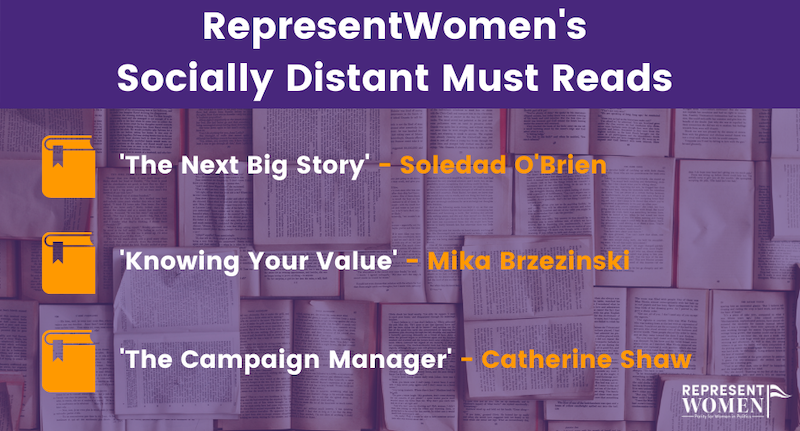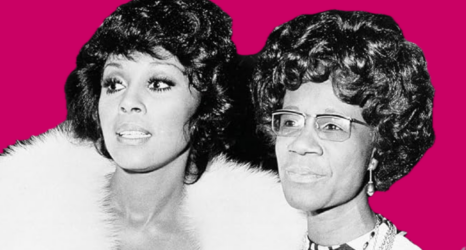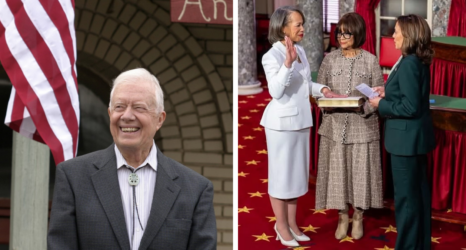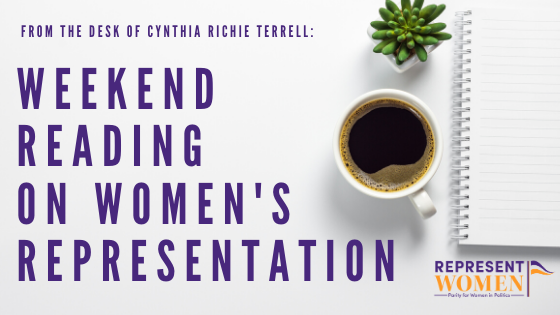
Weekend Reading on Women’s Representation is a compilation of stories about women’s representation in politics, on boards, in sports and entertainment, in judicial offices and in the private sector in the U.S. and around the world—with a little gardening and goodwill mixed in for refreshment!
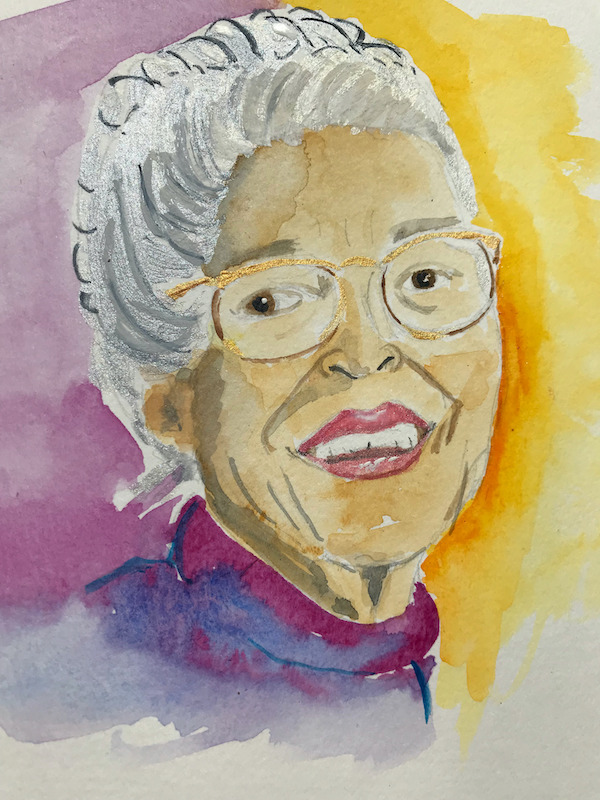
I have always felt a little conflicted about Black History Month and Women’s History Month. On the one hand, there is a risk of ignoring the many contributions of women and African Americans during the remaining 11 months, but on the other hand it’s an opportunity to focus on true American leaders who have set the stage for the work we are doing now.
Claudette Colvin, interviewed by Roni Jacobson for Teen Vogue, explains her pivotal and pioneering role in the civil rights movement:
On March 2, 1955, nine months before Rosa Parks refused to give up her seat to a white passenger on a bus in Montgomery, Alabama, Claudette Colvin, a 15-year-old Black teenager, did the same thing.
Parks is remembered for having sparked the Montgomery Bus Boycott, which Colvin helped end more than a year later when she, along with co-plaintiffs Mary Louise Smith, Aurelia Browder and Susie McDonald, served as witnesses in Browder v. Gayle, a case that ended segregation in public transportation not just in Alabama, but eventually all across the United States after the Supreme Court affirmed the ruling.
Parks became an icon of resistance. Meanwhile, Colvin became an outcast, branded a troublemaker within her community after her initial arrest and conviction. She was abandoned by civil rights leaders when she became pregnant at 16. Although she has gained recognition in recent years — a book about her life won the National Book Award in 2009 — Colvin is still largely glossed over by history and her immense contribution and sacrifice has never been officially recognized by the U.S. government, as Parks was.Teen Vogue reached Colvin by phone at her home in New York to talk about her experience. The following is a condensed and edited version of those conversations.Teen Vogue: Tell us about the day of your protest.
Claudette Colvin: I was in 11th grade. It started out a normal day.We got out early and 13 of us students walked to downtown Montgomery and boarded a city bus on Dexter Avenue, exactly across the street from Dr. Martin Luther King’s church. As the bus proceeded down Court Square, more white passengers got on the bus. In order for this white lady to have a seat, four students would have to vacate because a white person wasn’t allowed to sit across from a colored person. So the bus driver asked for the four seats and three of the students got up. I remained seated.
History had me glued to the seat. Harriet Tubman’s hands were pushing down on one shoulder and Sojourner Truth’s hands were pushing down on the other shoulder. I was paralyzed between these two women, I couldn’t move.
February was, at that time, only Negro History Week, not history month. But the faculty members at my school said we are gonna do it the whole month because African Americans — at that time we were called “negroes” — were deliberately kept out of American history. The boys liked to talk about Jackie Robinson, breaking the baseball barrier. My instructor talked about Sojourner Truth and Harriet Tubman. We started talking about the injustice and how we were discriminated against locally. That’s why I was so fired up and so angry when the bus driver asked me to get up. It was more than myself.
Some white students [on the bus] were yelling: “You have to get up, you have to get up.” And a colored girl, one of the students said, “Well she don’t have to do nothing but stay Black and die.”
We were still on our best behavior taking all of the insults from the white passengers. The bus driver knew that I wasn’t breaking the law, because these seats were already for colored people. Under Jim Crow law, the bus driver could ask you to give up your seat at any time but the problem was that [the number of seats for Black and white people had to be even]. He drove the bus about four stops, and when we stopped, traffic patrol got on the bus and asked me to get up. I told him I paid my fare and said, “It’s my constitutional right!” The patrol officer yelled to the bus driver that he didn’t have any jurisdiction here.
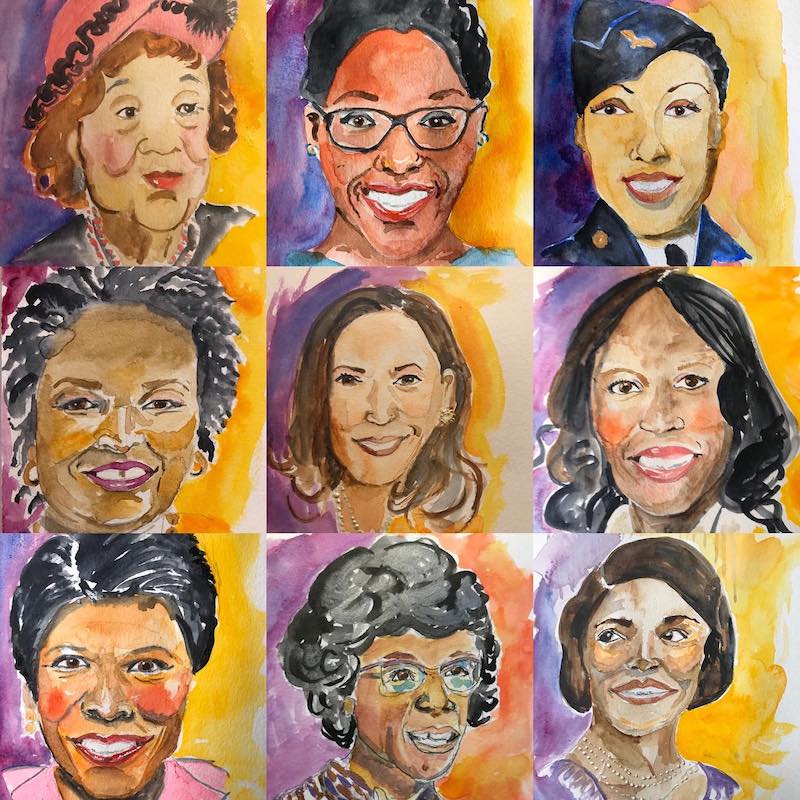
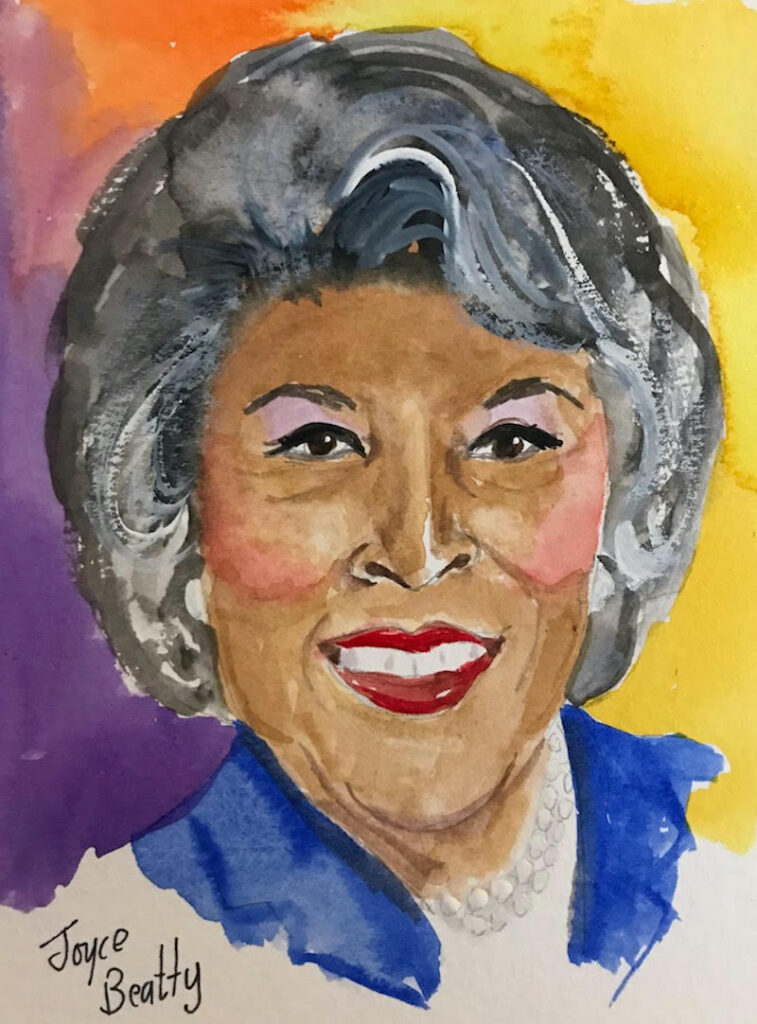
Black women’s political power has increased significantly in the 66 years since Claudette Colvin refused to give up her seat to a white passenger on a bus in Alabama. According to this article in The 19th* by Errin Haines, Black women are leading the Congressional Black Caucus:
As the Congressional Black Caucus marks its 50th anniversary, four Black women are leading the group and its three auxiliary organizations.
New CBC Chair Rep. Joyce Beatty, CBC Foundation Executive Director Tonya Veasey, CBC PAC Executive Director Yolonda Addison, and CBC Institute Executive Director Vanessa Griddine-Jones are shaping the caucus’ legislative and political priorities amid a national reckoning aimed at addressing racial inequality. They all say they are among the Black women at the forefront of these issues.
“Black women are just tired of being behind the scenes and doing all the work and not getting all the credit,” Addison said. “They say if you want something done, ask a busy person. … Black women are the busiest people I know, and we’re finally being seen for getting things done.”They are leading the organizations at a time when Black women’s political leadership is in the spotlight, as Kamala Harris has become the first woman and Black vice president. And while a record number of Black women, 26, are now serving in Congress and have helped grow the CBC to its largest numbers ever, none are in top roles in party leadership in the U.S. House, and no Black women are serving in the Senate.
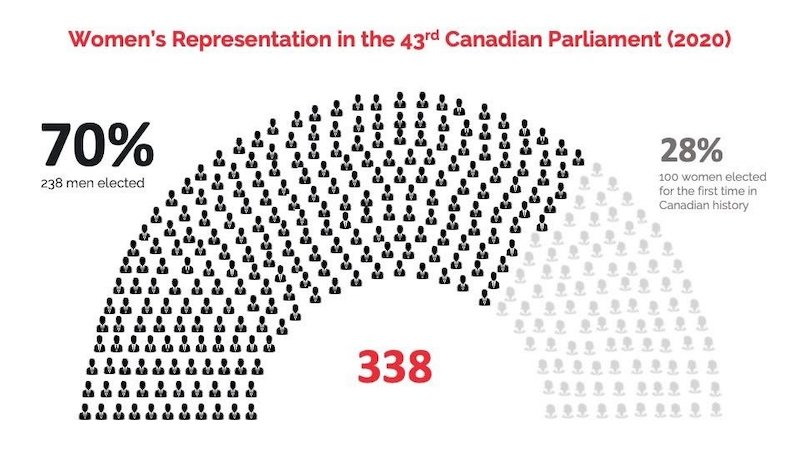
The United States has finally gotten close to our neighbor to the north in the percentage of women in office at the national level, but barriers still persist in both countries that keep women from running according to this piece in iPolitics by Anil Wasif and Maisha Kabir:
Despite being informal leaders in their communities, women are six times less likely than men to receive a nomination. Compared to men, women have received 852 fewer nominations, on average, in every election since 1921. This under-representation is another reason why so many women lack the drive to pursue elected office.
Political establishments, i.e., “gatekeepers,” nominate candidates who have easy access to money. Women earn less, on average, than men. Men not only raise more money than women, but they also donate more to male candidates. Hence, financing their election campaigns becomes a major barrier to women, and an even greater deterrent to women of colour.
The news media contribute too often to negative stereotypes when covering women in politics. Female politicians are often asked about their appearance and personal life, i.e., “negative viability coverage,” whereas men are asked about their political agendas. Women also typically receive less coverage by the news media than their male counterparts. Such gendered coverage dissuades people from voting for women, and lowers confidence in their political ability, thus discouraging women from running for office in the first place.
Gender stereotyping and discrimination are consequential and recurring contributions to low electoral participation. Explicit sexism is based on gender stereotypes, prejudice, and discrimination. One in five Canadians hold explicitly sexist views, making them less likely to nominate or vote for female politicians. Women internalize such overt sexism, which contributes to their lack of confidence and, ultimately, lowers their interest in running for office.
A major reason that women do not win consistently when they run in the U.S. and Canada is of course the winner take all electoral system that is an antiquated remnant of our colonial past. I am so pleased that a growing cohort in Congress supports legislation that will create more open seats where women have a better chance of winning when they run. As a reminder just 5% of the 180 or so women who ran as challengers won in 2020, while an encouraging 40% of women who ran in open seat races won.
There was a good piece in In These Times about democracy reform legislation pending in the House, along with this piece in Yahoo News about Representative Don Beyer’s Fair Representation Act that includes this interview (I am one of the wives mentioned!). When reintroduced in the 117th Congress, Beyer’s bill will include an increase in the number of House members along with ranked-choice voting in multi-seat districts that will lead to a significant increase in the number of women elected:
Some House Democrats hope to pass legislation this year that would give voters the option to list their choices in order of preference in future federal elections, a practice known as ranked-choice voting.
It’s part of a package of reforms designed to reduce extremism in politics, making politicians more responsive to the majority of voters rather than the noisy minorities in both parties. Advocates also want to increase the number of House members for the first time in over 100 years, and to move to multimember congressional districts.
“The most likely piece, which I hope we can pass this year, is just ranked-choice voting in primaries and general elections for federal elections,” Rep. Don Beyer, D-Va., told Yahoo News.
The package of reforms is “a medium- to long-term project,” Beyer said in an interview on “The Long Game,” a Yahoo News podcast. But it’s hard to know how many Democrats in Congress would support such legislation, much less Republicans.
But, Beyer said, “every year, it becomes more plausible as ranked-choice voting is adopted by lots of different states and by cities. People who are afraid of it look and say, ‘Oh, this is how it works. I understand this. This is good.’”The state of Maine used ranked-choice voting for the first time statewide in 2018, and Alaska voters approved the method in a referendum last fall. At the same time, Massachusetts voters rejected it.
But the practice is gaining enough steam elsewhere in the U.S. that it is being tested incrementally. New York City is using it for the first time this week in a special election for a City Council seat, and will use it again this June in its closely watched mayoral primaries.
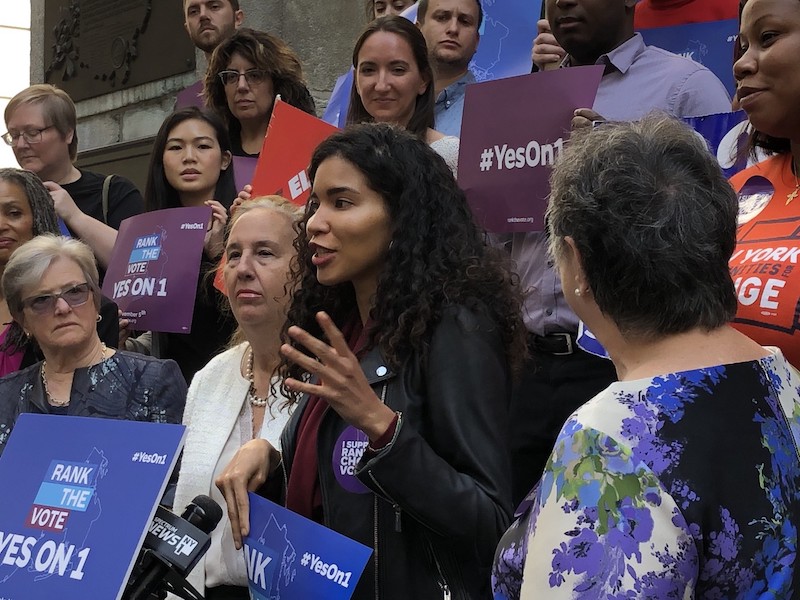
As the story above mentions, ranked-choice voting was used for a special primary election in NYC this week as Kaycie Goral, RepresentWomen’s communications fellow, reports in this piece on Medium:
On Tuesday, ranked choice voting (RCV) returned to New York City – putting an end to a 74 year hiatus of the voting system. Following the success of the “Yes on 1” ballot measure in November 2019, ranked choice voting will be used for the first time since 1947 in NYC to fill a Queen’s city council seat that has been vacant since November 2020. In the coming months, ranked choice voting will also be used in at least four local elections and the highly-contested New York City mayoral primary in June.
New York City joins 20 other local jurisdictions and the state of Maine already using the system. To date, 21 local jurisdictions use ranked choice voting in the United States. Between 2018 and 2020, an additional eight municipalities and Alaska adopted ranked choice voting. This system is also used in six states for overseas voters, colleges and universities across the country, and within private organizations – including the Academy of Motion Picture Arts and Sciences.
The expanded use of ranked choice voting in the United States is an exciting development, because ranked choice elections are often associated with greater turnout and positive outcomes for women and people of color. According to recent research, ranked choice voting stands to improve the descriptive representation of women in government by rewarding positive, issue-focused campaign styles, reducing the cost of elections, and eliminating the “spoiler effect.” Overall, ranked choice voting ensures that elected officials win with a majority of support rather than a plurality of votes, and this is crucial for both women and people of color. According to officials elected by RCV, they govern better when they have majority support.
In a ranked choice election, voters rank candidates in order of preference. In races where there is one winner, the candidate who receives a majority (50% +1) of first-choice votes wins. But, if no candidate receives a majority of votes in the first round, the candidate with the fewest votes is eliminated. Ballots with the eliminated candidate ranked first are then reallocated to their second-choice candidates; this process continues until a candidate receives 51 percent of votes.
The history of RCV in NYC
While it is true that ranked choice voting is gaining new momentum and popularity across the United States today, it has a long history of use in U.S. cities, and many historical “firsts” for women and people of color were achieved while ranked choice voting was in practice.
In 1936, following rampant corruption and the political stranglehold of Tammany Hall, voters in New York City adopted electoral reform measures including ranked choice voting in its proportional form, often referred to as the single transferable vote, to elect the Board of Aldermen, a precursor to the modern city council. The implementation of ranked choice voting led to the election of the first woman, Genevieve Beavers, and the first African-American man, Adam Clayton Powell Jr. to the New York City Board of Aldermen.
In addition to paving the way for these historic representation victories for women and the Black community in the city, ranked choice voting fostered a vibrant system that prevented the Board from continuing as a “rubber stamp” for the Democratic political machine. While ranked choice voting was in use, the Board of Aldermen featured lively debate, cross-party coalitions, and consensus building. This revitalized political climate resulted in 80 percent of all city legislation passing unanimously between 1936 and 1947.

There are many reasons to support efforts to advance women’s representation and leadership in politics but one growing body of data suggests that women are particularly good at meeting the needs of their constituents, as this piece in The Washington Post by Bailey Sanders and Danielle Thomsen confirms:
Does electing women legislators have consequences for voters? Research suggests that it does. Studies at both the state and federal levels find that women are more active and productive than their male counterparts on a variety of policy-related activities: They sponsor more legislation, are more effective at moving bills through the legislative process and bring more money to their districts.
But our recent study shows that women stand out in another area as well: constituent service.
Here’s how we did our research
We conducted an audit study in March 2016 of 6,000 U.S. state legislators to see whether female legislators were more responsive to their constituents than their male counterparts. We obtained the email addresses of nearly all state legislators who were in office at that time through the state legislature websites of all 50 states. We waited for 30 days to see if they replied and then coded whether they responded to our email and what kind of information they provided. Some state legislatures have more women than others; our sample of nearly all state legislators in office at that time thus reflects the gender imbalance in each legislature because we sought to include the full sample of male and female legislators where possible.
We sent each legislator a simple request about how to register to vote. The text in our email was very similar to what previous studies of legislator responsiveness have used. The email included a fictitious name of someone writing that he or she was trying to figure out how to vote for the upcoming election. The individual asked who they should call to register. As has happened in earlier research, we treated responses from either the legislator or a staff member as equivalent. However, we also coded whether the response came from the legislator or a member of their staff. The results are the same when we exclude staff responses and when we look only at state legislatures with no staff at all. In other words, staff responses are not the reason behind the patterns we uncovered.
We found that women legislators were more likely to respond to constituent requests than their male counterparts. The likelihood that women legislators replied to our email was 59 percent, compared to 55 percent for men. We also found that women legislators were more likely to answer helpfully: 40 percent of women provided details on how to register while only 34 percent of men did. Both of these differences are statistically significant.

While women politicians may be outpacing their male colleagues in constituent service, women workers are still underpaid compared to their male colleagues—and fixing that inequity may take over 200 hundred years, according to this Equality Lounge conversation between Shelley Zalis and Sara Wechter at this year’s virtual Davos gathering:
Think of how different the world was two centuries ago. There were no cars on the roads, no planes in the sky. The vast majority of women were relegated to the home; they weren’t leading companies or governing countries, or even voting for that matter. While we can’t possibly predict how the world will look 200 years into the future, one thing is certain: At the current rate of progress, we still won’t have closed the gender pay gap. In fact, the World Economic Forum’s projections show that we won’t achieve gender parity on a global scale until the year 2277 — and that isn’t even taking into account the decades of progress that have been undone by COVID-19. We’ve come a long way, but we must remember how far we have to go.
Our annual Equality Lounge @ Davos looked a little different this year — for one thing, we traded in the snowy slopes of Switzerland for our sofas and computer screens — but the conversations were just as impactful as ever. I [virtually] sat down with Sara Wechter, Global Head of Human Resources at Citi, to talk about why it has never been more important for organizations to take a stand for pay parity.
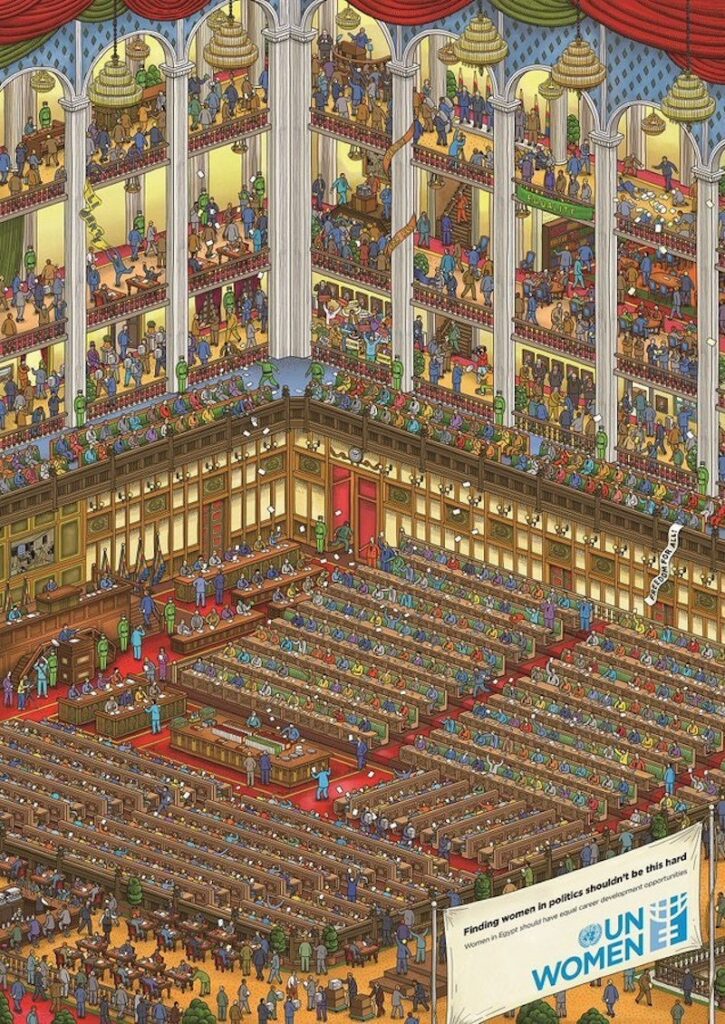
Parity in political leadership is also generations away at the current pace of change according to this post about a new U.N. report in #WomenLead by Akshi:
In the run-up to the 65th session of the Commission on the Status of Women, UN Women recently published a report on the global landscape in terms of women’s political representation and participation.
For us, it was reassuring to see a document of this stature articulate the many gaps, problems and challenges of our mainstream politics, which we’ve been writing about week after week. We hope it can also disrupt the inertia and get progress rolling. After all, we’re in 2021, and it’s high time!
The report minces no words in describing why progress remains slow even with more women in public life now:
“Men with power often resist women’s leadership, even within political parties. The attitude that women should not have public roles, enduring norms about gender roles and legal discrimination compound these challenges and devalue women’s contributions to decision-making.
“Organized opposition to women in public life is sometimes strong and violent, with the situation worsened by democratic backsliding, increased social and political polarization and deepening inequality.”
So how do we – as a world – fare when it comes to equal representation? Here are some important data-points that the report mentions. Brace yourself, and keep a glass of water close (or whatever tonic helps you stay calm):
The representation gap is most skewed at the top-most level of politics. As of November 1, 2020, women were serving as heads of state or government in only 21 countries. (The world has nearly 200 countries, just saying).
As many as 119 countries have never even had a woman lead them. More than half of all countries have… *never, ever*… been led by a woman.
At the rate of progress so far, parity at the top of the political hierarchy is another 130 years away, the report estimates. 130 years! Does that mean some of us may need to be born, not once, but twice over to see that day? #PleaseSayThisIsAJoke🙄🙄
In terms of ministerial posts, nearly one in five ministers globally is a woman. In an encouraging trend, the report notes that women are increasingly leading ministries in “non-social sectors”, such as defence, the environment, employment and trade/industry.
However, as of January 2020, only 14 countries had cabinets with half or more positions held by women.
At the beginning of 2020, only one in every four members of parliament around the world was a woman. While this share is double of what it was in 1995, gender parity in national legislative bodies will not be achieved until 2063 if we keep going at this rate.
The numbers are better at the local level, but only because of what we are comparing it with. Data from 133 countries and areas show that more than two million women serve in local bodies, and comprise a little over a third (36 percent) of all members elected at the local level.
The report finds that quotas for women have been the main policy intervention that have improved women’s participation in national and local decision-making. However, most countries that introduced quotas don’t target parity, but reserve 5 to 30 percent of the total seats for women.
In terms of the way forward, the report emphatically notes:
“Transformative change to advance gender equality and women’s empowerment depends on political will, close cooperation between women and men, networking among women in different decision-making positions, gender-responsive institutions, and the provision of greater financing for women in public life.
“It is critical to apply effective and ambitious quotas, appoint an equal number of women and men to all public positions, eliminate violence against women and enable the participation of all groups of women, especially young women, to strengthen women’s voices for the achievement of gender equality for women and girls.”
Some legal and regulatory steps the report has recommended for countries:
Adopting quotas,
Establishing targets and timelines to achieve parity of representation,
Reforming policies or laws that discriminate against women,
Implementing gender-responsive institutional reforms,
Making available high-quality financing in support of women’s participation in public life.
There is much to agree with and appreciate in the report. But the real test starts now – we hope all stakeholders take note.
There was a great piece about women’s representation advocates in Liberia that I found very uplifting because it conveys a sense of vitality and determination to change policy that is sometimes missing in the American conversation about how to increase the number of women in office:
Scores of Liberian women from diverse spectrum, on Monday expressed dismay over what they referred to as alteration in the proposed new elections law of Liberia affecting women’s representation.
In a statement presented to the Women Legislative Caucus at the Capitol Building, the women emphasized that there were extensive national consultations held by the National Elections Commission (NEC), Civil Society groups and observers throughout the last two years, stressing that all agreed that it is of great importance that Liberia strengthens the Elections Law to give women a chance to sit at the same table as men to discuss and pass legislation affecting all.
“Following these consultations, the NEC proposed, amongst other things, strengthening Section 4.5 of the new Election Law by making it compulsory for political parties to include as minimum of 30% of either gender in their national executive and their candidate lists for election, and giving the NEC the power to reject any candidate list that does not comply,” Madam MacDella Cooper intimated.
The women, quoted in the statement said, “It is with profound dismay that we have learned that the Houses’ Committee on Elections and Referendum met to discuss the draft of amendments to the new Elections Law of 1986, and decided to remove the proposed amendments to Section 4.5 before the draft comes to plenary.”
“This is a complete violation and disrespect to all international and regional laws and protocols our country signed and ratified. Section 4.5 1b does not give women seats on a silver platter, but rather gives them a space to freely compete and campaign as the men do, and win,” the women intoned….
Receiving the communication on behalf of the Women Legislative Caucus, Representative Rosana G. D. H. Schaack promised to continue the advocacy for the passage of significant laws affecting women.
Also speaking at the event, Madam Julia Duncan-Cassell, former Minister of Gender, Children and Social Protection (MGCSP) encouraged all women groups to remain committed in the effort intended to give women a political voice in the country.
Meanwhile, the women of Liberia are expected to hold a sit-in action today, Tuesday, at the grounds of the capitol Building in continuation of efforts to draw the lawmaker’s attention so as to reinstate the removed portion of Section 4.5 of the new Elections Law.
The gathering was attended by several women groups including WONGOSOL, AWLN, Movement for One Liberia, National Civil Society Council of Liberia, Women’s Rights and Gender Justice, Coalition of Political Party Women in Liberia and Liberia Women Advocacy Network (LIWANET) as well as representation from the Ministry of Gender, Children and Social Protection (MGCSP) amongst others.

There was an interesting piece in The Jordan Times about the work to increase women’s representation in Jordan that again includes substantive policy proposals:
Female MPs and activists have called on the government to take advantage of the Kingdom’s marking of the centennial of the foundation of the Jordanian state by increasing women’s representation in decision-making positions.
Madaba MP Asma Rawahneh said the government needs to consider starting the new 100 years for Jordan by considering the increase of women in decision-making positions and eliminating all the laws that discriminate against them.
“It is time to change the culture that still perceives women in a certain stereotypical manner, especially when it comes to appointing individuals in high-level positions and increasing their presence in the legislative bodies,” Rawahneh said.
Jordan will celebrate the centennial of the foundation of the Jordanian state upon the arrival of His Majesty the late King Abdullah I in Maan in November 1920 with several major activities in various part of the Kingdom.
Rawahneh’s remarks were made during an online event organised by Solidarity Is Global Institute (SIGI) last week.
The event was part of the “Eye on Women Programme to Monitor the 2020 Elections from a Gender Perspective”, titled “Women’s MPs Stereotyping Role”.
Rawahneh added that although women are “less corrupt and more committed, we are always facing barriers and we feel that we are being fought against”.
“I feel that we are always placed in a certain block that limits our capabilities and abilities to make the necessary change,” Rawahneh stated.
Ajloun MP Safa Momani echoed Rawahneh’s demands stating that female MPs usually have to exert double the efforts compared to male candidates.
“We need to change the social attitudes towards women’s involvement in the political life because we are capable of making a huge difference if we were given the appropriate chances and atmosphere,” Momani told the gathering.
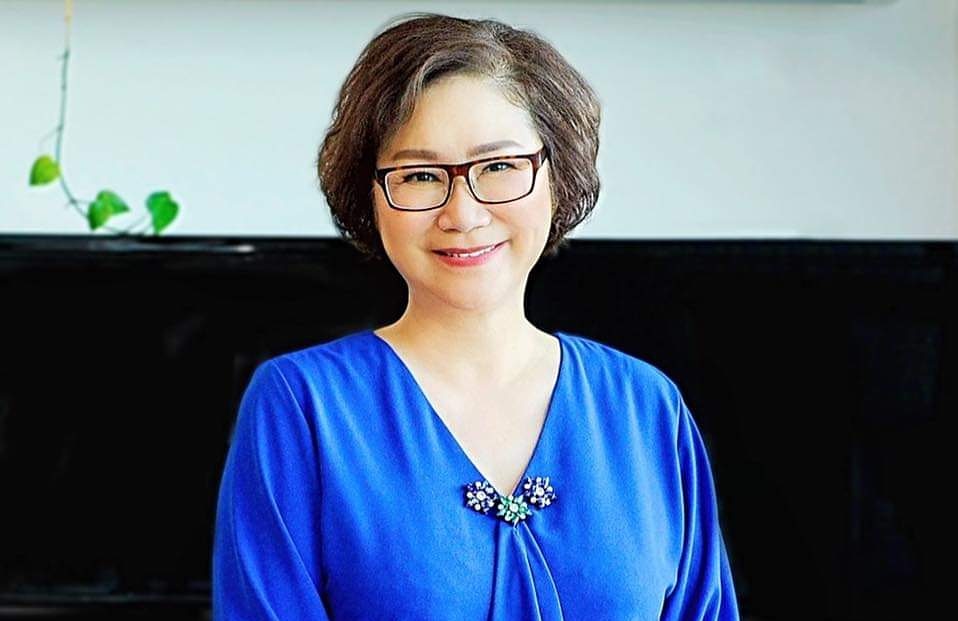
Finally, this story about the work for women’s representation in Malaysia coveys a pragmatic idealism that I find inspiring:
It is high time the government enacted legislation that compels at least a 30% women participation in decision-making roles in the public sector, said Sabah PKR chief Christina Liew.
The Tawau MP said while it was imperative for governments at all levels to increase the percentage of women in such roles, including in the legislature and the Cabinet, she conceded it will remain an uphill struggle without undivided support from the menfolk.
“Over the past few decades, this crucial point has been publicly acknowledged by many women political leaders, activists and women’s rights groups in the country.
“For the past 20 years, Malaysian women politicians have also been clamouring for the targeted 30% women’s political representation in Parliament as well as in the state legislative assemblies but to no avail,” she said here today.Liew recalled that women parliamentary speakers and parliamentarians from Commonwealth countries had in 2015 called for Malaysia to enact legislation of the 30% policy for women in such roles in the public sector.
The former deputy chief minister said the women MPs made the call during the Commonwealth Parliamentary Association (CPA) executive committee meeting hosted by Malaysia in Sabah that year.
“As governments around the world have legislated their 30% policy for women’s decision-making in the public sector, why not Malaysia?
“Only then, I believe, can Malaysian women attain the target for women’s representation in key decision-making positions,” she said, adding such legislation should also be expanded to include women’s political representation at all levels.

There is some good news this week: Emily Vogel writes for The Wrap that women are well-represented at the Sundance Film Festival this year:
This year feels like some kind of balance has been achieved. There is no mistaking these films for tokens or placeholders.
Among all of the 72 feature films announced for the festival in December, 47% were directed by women, 3% by non-binary individuals, 43% by BIPOC and 8% by one or more LGBTQ+ filmmakers. (Two more features, both directed by men, were later added.)
This includes “CODA” by writer-director Sian Heder, the film that broke all Sundance sales records with a $25 million buy by Apple this weekend, about a deaf family and their hearing daughter who chases her dream as a singer.
It includes “Passing,” by actress-turned-filmmaker Rebecca Hall, starring Tessa Thompson and Ruth Negga as well-to-do women who can “pass” on either side of the racial divide, set in 1920s Harlem.
It includes “Land,” the widely-praised first feature by actress Robin Wright, already acquired and launched into the Academy Awards race. And many more!
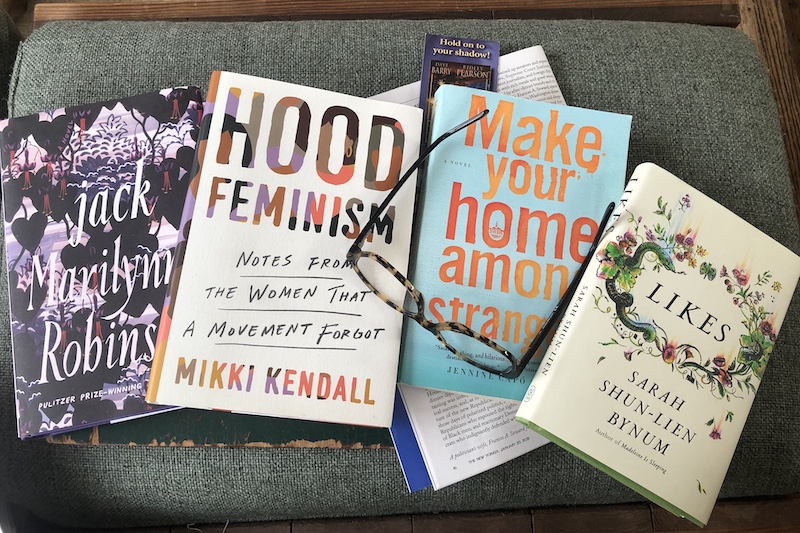
I am excited to report that I have surpassed my book-reading goals on Goodreads and have already read five novels in 2021! I hope you are finding ways to relax amidst the political and meteorological storms that are buffeting us.
Here are this week’s suggested reading from the team at RepresentWomen:
